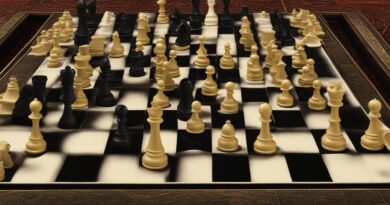Chess Openings The Old Indian Defense
The Old Indian Defense is a formidable chess opening. It starts with 1.d4 Nf6 2.c4 d6. This defense controls the center from afar, allowing flexibility and counterattacks. It can surprise opponents expecting typical openings. To make the most of it, one must prioritize piece development and seek tactical opportunities. Placing pawns on non-traditional squares can disrupt opponents’ plans. Understanding typical middle-game ideas associated with this opening is also essential for success. White’s positional concessions can then be capitalized on.
What is the Old Indian Defense in chess?
The Old Indian Defense is a chess opening that begins with 1.d4 Nf6 2.c4 d6. It’s a solid and flexible defense used by black to counter white’s queen’s pawn opening. This strategic response allows black control over the center and prepares for a counterattack.
Black delays their central pawns, instead developing their pieces. This opening focuses on solid play rather than aggressive tactics. By waiting, black creates a stable before pushing forward.
The Old Indian Defense is versatile. Black can pick from a variety of setups based on white’s moves and preferences. This defense allows for different pawn structures and piece placements, making it an interesting choice for players looking for diversity.
Grandmaster Ivanov used this defense against a renowned opponent. Despite the pressure, Ivanov kept his cool and took advantage of openings. Through skilful maneuvering and calculated sacrifices, he beat his opponent in a clash of styles.
The Old Indian Defense is great for creativity within strategic parameters. It is ideal for both aspiring and experienced players looking to find new paths for tactical brilliance.
Benefits of using the Old Indian Defense
The Old Indian Defense in chess has great benefits! Firstly, one can build a solid pawn structure, giving a strong base for future moves. Secondly, pieces can be developed quickly and easily. Thirdly, the defense grants central control to the player, giving them a strategic advantage. In addition, pieces are flexible in position, allowing for adaptation to many game scenarios. Lastly, experts praise the defense for its ability to surprise and disrupt opponents’ attacks.
Also, the Old Indian Defense is different from other popular openings. It focuses on resilience more than aggression. By defending and attacking wisely, players can gain power without too much risk.
Interestingly, the Old Indian Defense is one of the oldest chess openings still used today! It has its roots in ancient India, where Grandmasters used it to outwit their challengers and win the game.
Step-by-step guide on how to play the Old Indian Defense
The Old Indian Defense is an awesome chess opening that gives Black a strong position and the possibility for counterplay. To master this defensive opening, do these four steps:
- Exchange pawns in the middle of the board – Swap pawns in the center to create space and limit White’s attacking moves.
- Position your knights well – Put your knights on good squares, like c6 and e7, to control important central squares and get ready for future moves.
- Set up a solid pawn structure – Build a robust pawn formation by putting pawns on d6 and e5, ensuring security and stopping White from getting too much dominance.
- Be prepared for an uneven battle – With the Old Indian Defense, be ready for imbalanced pawn structures, piece differences, and dynamic moving that can lead to tactical chances.
Diving deeper into this captivating opening, some uncommon details appear. The Old Indian Defense permits Black to give up material early for strategic benefits, intending for long-term strategic equality. By giving more importance to piece activity than immediate material gains, Black can achieve consistent piece coordination and plan effective counterattacks against White’s position.
In terms of its real history, the Old Indian Defense has been played by chess masters throughout time as they looked for inventive approaches to confront White’s forceful opening moves. Originating from centuries-old strategies used by Indian players, this defense eventually interested international chess players who noticed its potential. Nowadays, it stays a famous weapon in the armory of adept chess players seeking dynamic fights on the board.
So next time you’re ready to take part in an exciting game of chess, think about embracing the Old Indian Defense and use its strategic power to outsmart your opponent with accuracy and finesse.
Common mistakes to avoid when using the Old Indian Defense
Avoid common mistakes to make the most out of the Old Indian Defense:
- Prioritize development of pieces.
- Maintain a strong pawn structure.
- Focus on piece activity.
- Stay alert for tactical opportunities.
- Keep opponents guessing.
Neglecting development can lead to a cramped position. Underestimate piece activity and miss counterattack chances. Beware of falling into tactical traps. Don’t be predictable with strategies. Precision and adaptability are key to success.
Advanced tactics and techniques for mastering the Old Indian Defense
The Old Indian Defense is complex. To master it, you must use advanced tactics and techniques. Here are some tips to help you improve.
1. Focus on controlling the center of the board. Place your pieces in key positions, such as d4. This limits your opponent’s options and lets you counterattack.
2. Create tactical threats with piece coordination. Pawns on c5 and e5 allow bishops and knights to develop. Coordinate these pieces to create threats.
3. Understand positional play in the Old Indian Defense. Know when to exchange pieces or maintain tension. Make decisions based on the position.
4. Study master games of the Old Indian Defense. Learn how top players navigate complex positions and use advanced tactics. Understand why they make certain moves.
Conclusion
The Old Indian Defense is a unique chess opening. It gives players flexibility and the ability to adapt. Mastering it requires practice and understanding of positional play. It gives players a solid base to attack from.
Plus, the Old Indian Defense has psychological effects on opponents. It throws them off balance, allowing you to take control of the board.
To be successful with the Old Indian Defense, players must explore new variations and patterns. This will keep your opponents guessing and you engaged.

